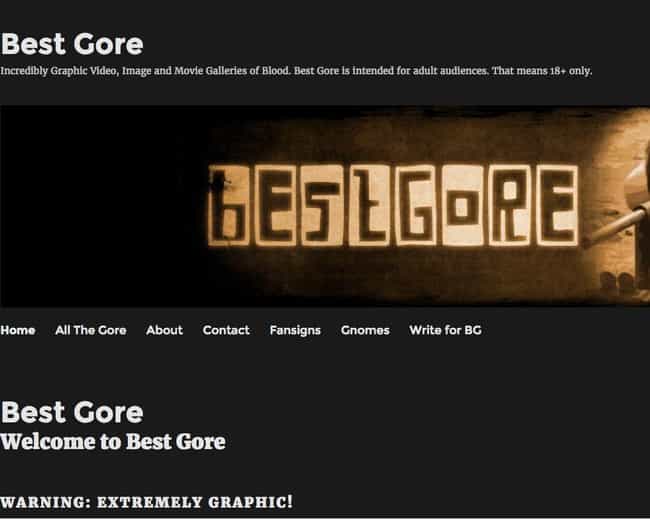Have you ever wondered about the dark corners of the internet, the places where the veil of civility thins and the rawest, most disturbing aspects of human existence are laid bare? Prepare yourself, for the world of "gore" websites, forums, and communities is not for the faint of heart; it is a realm where the graphic depiction of violence, death, and suffering is not only present but often the central focus.
The digital landscape is vast and, in many ways, untamed. Within this expanse, certain platforms and communities have carved out niches for content that pushes the boundaries of what is considered acceptable. These spaces, often referred to as "gore sites," are dedicated to the sharing of real-life death videos, images depicting acts of violence, and other content that most would find profoundly disturbing. The very nature of this content raises complex questions about freedom of expression, the impact of exposure to graphic violence, and the ethical responsibilities of platforms and individuals.
The allure of these spaces is often shrouded in mystery. Some are driven by morbid curiosity, a desire to witness the extreme. Others may be drawn to the sites for their perceived authenticity, a stark contrast to the sanitized violence often found in mainstream media. Still others may be seeking a sense of community, a place where they can discuss the darker aspects of human existence without judgment.
Within these forums, discussions delve into the legality of such content, particularly in the United States where freedom of speech is protected, but other countries have stricter laws. The legality often hinges on the intent of the content, the nature of the violence depicted, and the context in which it is presented. True crime events from all over the world become a source of content. Viewer discretion is always advised. These sites make even the most graphic shows on television seem like children's programming. Those who choose to delve into this world may find themselves changed, the line between fascination and revulsion blurring with each click. "I've seen some of the worst gore the internet has to offer," one user writes, "And it took me a while to come to terms with it. Gore no longer shocks me and I developed a strange fascination with it. But I have lost a part of me that was."
For those seeking something less extreme, the digital world also offers alternative avenues. One such example is the use of "rekt threads" on platforms like 4chan. These threads often feature CCTV footage of accidents, suicides, or acts of extreme violence. These videos often reflect the consequences of poor safety measures, suicides, or simple negligence, making them a unique source of content that exists in the same digital ecosystem.
The core of these spaces is the sharing of graphic content. One subreddit, dedicated to medical gore, aims to foster medical discussion and learning through the depiction of human vulnerability. The focus is always on providing context and encouraging interaction, with the goal of providing a space for education through the gruesome reality of humankind.
The search for alternative gore websites continues, as sites like Bestgore.com have been shut down, leaving many looking for new sources of this type of content. The desire to find new gore sites underscores the draw that some find in the darker sides of the internet. The quest can lead to an exploration of different kinds of content: cartel violence, car accidents, shootings, street fights, and more. A user search led them to sites that barely come close to matching the kind of gore that Bestgore.com provided. As the landscape evolves, so too does the content, and the forums for sharing it.
Here's a comprehensive overview of some key aspects related to gore websites and similar content, formatted in a table to provide a clear and concise understanding:
| Category | Description | Examples / Related Terms | Legal Considerations |
|---|---|---|---|
| Content Focus | Graphic depictions of violence, death, and suffering. | Real-life death videos, images of violent acts, true crime events, accidents, suicides, medical procedures | Legal in the USA (with exceptions), stricter laws in other countries. Content legality often depends on intent, context, and the specific nature of the violence. |
| Types of Sites/Platforms | Forums, websites, subreddits, and social media groups dedicated to sharing and discussing gore content. | Bestgore (shutdown), Kaotic (active), LiveLeak (shutdown, archived), r/morbidreality, r/medicalgore, 4chan (rekt threads), Goregrish | Sites often operate in a legal gray area. Platform terms of service typically prohibit graphic content, but enforcement varies. |
| Motivations for Viewing | Curiosity, a desire to witness the extreme, fascination with death, a search for authenticity, community-building. | Morbid curiosity, thrill-seeking, desensitization to violence, exploration of human nature, seeking a sense of community. | Psychological impacts of exposure to graphic content are a concern. Potential for desensitization, emotional distress, and altered perceptions of violence. |
| Impacts of Exposure | Potential for desensitization, emotional distress, altered perceptions of violence, and psychological impact. | Anxiety, depression, nightmares, PTSD-like symptoms, a shift in ethical boundaries. | Viewing such content may lead to long-term psychological effects. |
| Related Concepts | The dark side of human nature, morbid curiosity, shock value, sensationalism. | True crime, snuff films, cartel violence, car accidents, medical anomalies, suicide. | Freedom of speech versus censorship, the ethics of content moderation, the role of platforms in the dissemination of disturbing content. |
Further exploration of this topic may lead to more questions and discussion. One must also consider the psychological toll of such viewing. Those who venture into these spaces must be aware of the potential for desensitization, emotional distress, and altered perceptions of violence. The experiences reported by those who have immersed themselves in this content should serve as a clear warning: these sites make even the most graphic shows on television seem like children's programming. For those interested in researching these issues, more information can be found at the following resource: Wikipedia.


